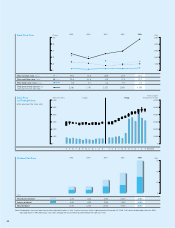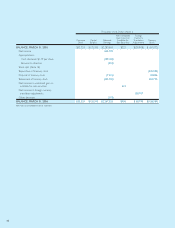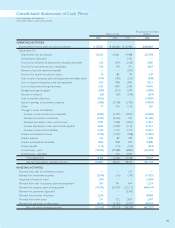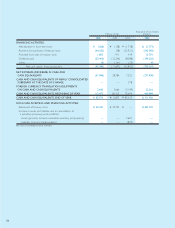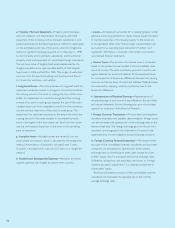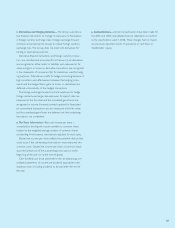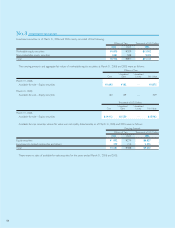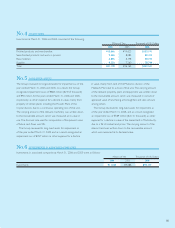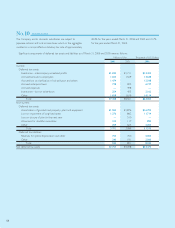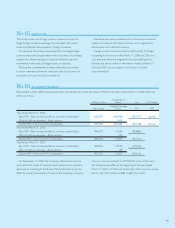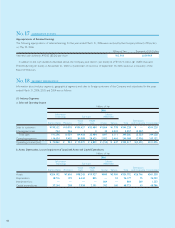Pentax 2006 Annual Report Download - page 55
Download and view the complete annual report
Please find page 55 of the 2006 Pentax annual report below. You can navigate through the pages in the report by either clicking on the pages listed below, or by using the keyword search tool below to find specific information within the annual report.
e. Property, Plant and Equipment—Property, plant and equip-
ment are stated at cost. Depreciation of property, plant and
equipment of the Company and its domestic subsidiaries is com-
puted substantially by the declining-balance method at rates based
on the estimated useful lives of the assets, while the straight-line
method is applied to buildings acquired on or after April 1, 1998
by the Company and its domestic subsidiaries, and to almost all
property, plant and equipment of consolidated foreign subsidiaries.
The net book value of tangible fixed assets depreciated by the
straight-line method was approximately 66.4% of total tangible
fixed assets in 2006 and 56.3% in 2005. The ranges of useful lives
are from 10 to 50 years for buildings and structures and from 5
to 10 years for machinery and vehicles.
f. Long-Lived Assets—The Group reviews its long-lived assets for
impairment whenever events or changes in circumstance indicate
the carrying amount of an asset or asset group may not be recov-
erable. An impairment loss would be recognized if the carrying
amount of an asset or asset group exceeds the sum of the undis-
counted future cash flows expected to result from the continued
use and eventual disposition of the asset or asset group. The
impairment loss would be measured as the amount by which the
carrying amount of the asset exceeds its recoverable amount,
which is the higher of the discounted cash flows from the contin-
ued use and eventual disposition of the asset or the net selling
price at disposition.
g. Intangible Assets—Intangible assets are carried at cost less
accumulated amortization, which is calculated by the straight-line
method. Amortization of software is calculated over 5 years.
Goodwill is amortized with a period of 20 years on a straight-line
method.
h. Research and Development Expenses—Research and devel-
opment expenses are charged to income when incurred.
i. Leases—All leases are accounted for as operating leases. Under
Japanese accounting standards for leases, finance leases that deem
to transfer ownership of the leased property to the lessee are
to be capitalized, while other finance leases are permitted to be
accounted for as operating lease transactions if certain “as if
capitalized” information is disclosed in the notes to the lessee’s
consolidated financial statements.
j. Income Taxes—The provision for income taxes is computed
based on the pretax income included in the consolidated state-
ments of income. The asset and liability approach is used to rec-
ognize deferred tax assets and liabilities for the expected future
tax consequences of temporary differences between the carrying
amounts and the tax bases of assets and liabilities. Deferred taxes
are measured by applying currently enacted tax laws to the
temporary differences.
k. Appropriations of Retained Earnings—Appropriations of
retained earnings at each year end are reflected in the consolidat-
ed financial statements for the following year upon shareholders’
approval or resolution of the Board of Directors.
l. Foreign Currency Translations—All short-term and long-term
monetary receivables and payables denominated in foreign curren-
cies are translated into Japanese yen at the exchange rates at the
balance sheet date. The foreign exchange gains and losses from
translation are recognized in the statements of income to the
extent that they are not hedged by forward exchange contracts.
m. Foreign Currency Financial Statements—The balance sheet
accounts of the consolidated overseas subsidiaries and associated
companies are translated into Japanese yen at the current
exchange rates as of the balance sheet dates except for share-
holders’ equity, which is translated at historical exchange rates.
Differences arising from such translation are shown as “Foreign
currency translation adjustments” in a separate component of
shareholders’ equity.
Revenue and expense accounts of the consolidated overseas
subsidiaries are translated into Japanese yen at the monthly
average exchange rates.


